MEA Pouch Packaging Market Size
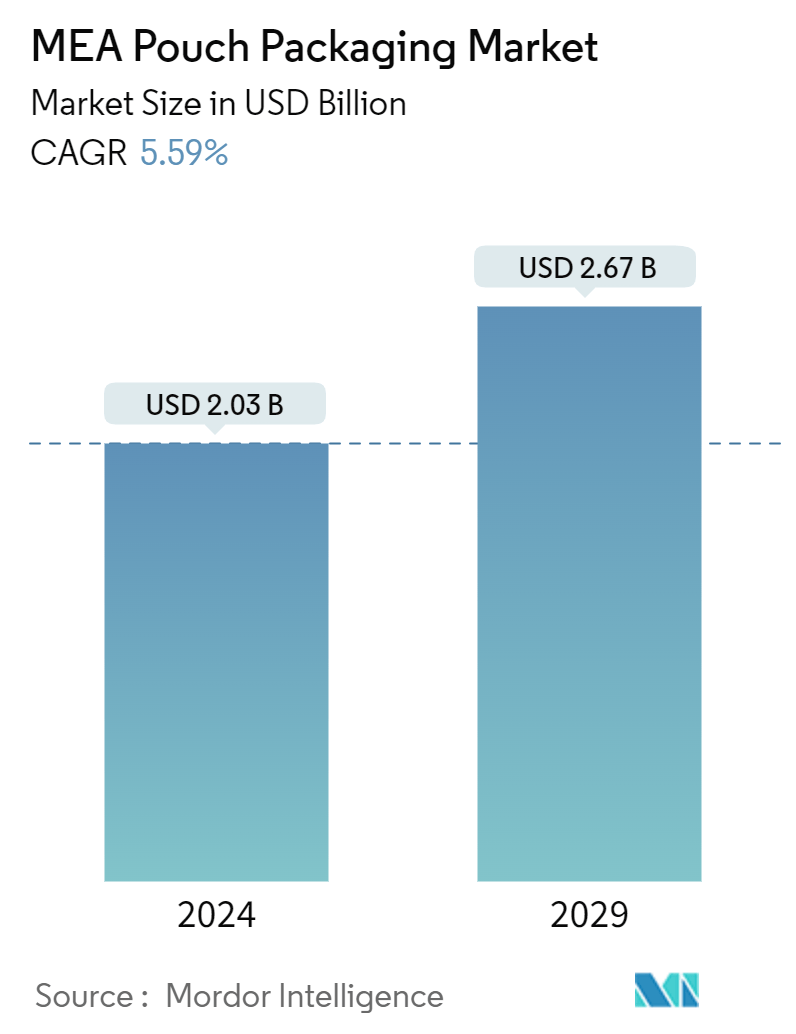
| Study Period | 2019 - 2029 |
| Base Year For Estimation | 2023 |
| Market Size (2024) | USD 2.03 Billion |
| Market Size (2029) | USD 2.67 Billion |
| CAGR (2024 - 2029) | 5.59 % |
| Market Concentration | Low |
Major Players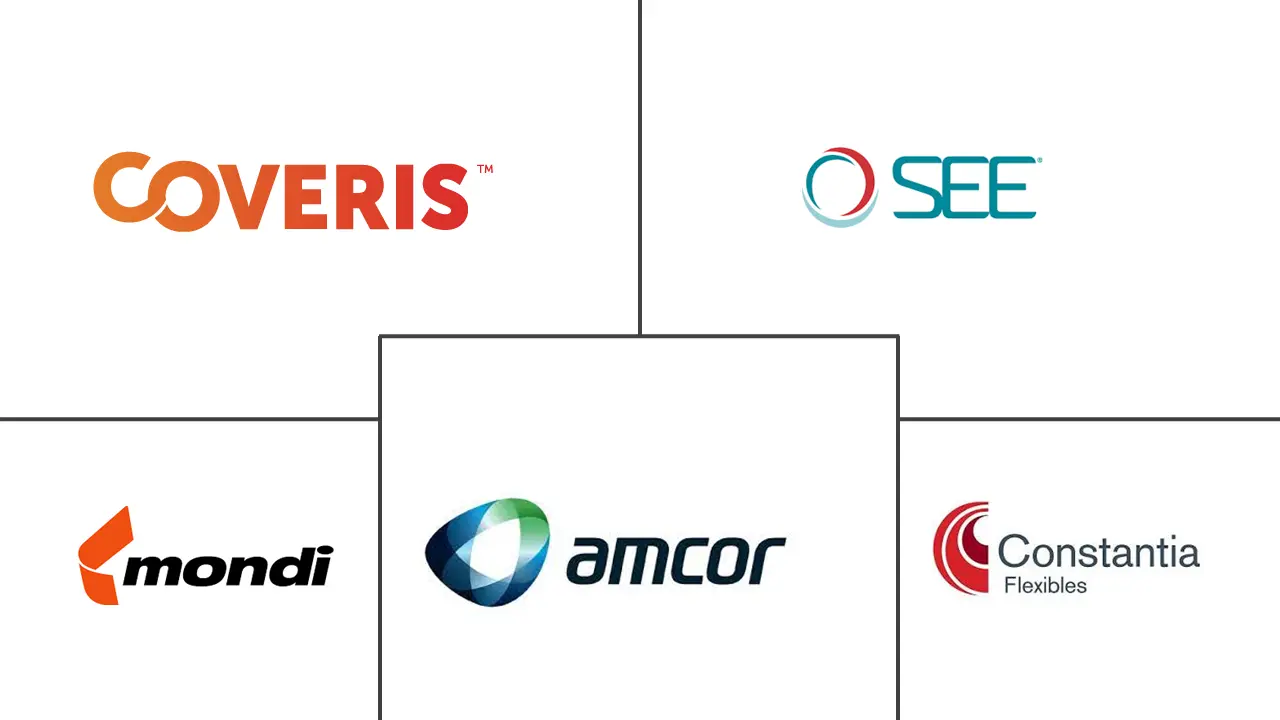
*Disclaimer: Major Players sorted in no particular order |
MEA Pouch Packaging Market Analysis
The MEA Pouch Packaging Market size is estimated at USD 2.03 billion in 2024, and is expected to reach USD 2.67 billion by 2029, growing at a CAGR of 5.59% during the forecast period (2024-2029). In terms of shipment volume, the market is expected to grow from 21.46 billion units in 2024 to 26.79 billion units by 2029, at a CAGR of 4.54% during the forecast period (2024-2029).
- Pouch Packaging involves using flexible materials such as plastic, paper, and aluminum foil to create pouches for various consumer products. Pouch packaging has become a dominant and versatile packaging solution in the global market, offering benefits like cost-effectiveness and convenience. These pouches come in different sizes and shapes, making them suitable for packaging various items, from food and beverages to personal care products and pharmaceuticals. In the Middle East and Africa, the packaging industry is undergoing a significant transformation due to shifting consumer preferences, increased urbanization, and the need for innovative packaging solutions, resulting in increased demand for pouch packaging.
- Economic development in the countries in the region has given rise to an expanding consumer base and increased disposable income. As more consumers have access to retail chains and global brands, the demand for innovative and appealing packaging solutions like pouches has surged. With an increasing prevalence of e-commerce in MEA, pouch packaging has proven to be an excellent solution to protect products during transit. The lightweight and durable nature of pouches is well-suited for this purpose. Pouch packaging is being enhanced with features like resealable zippers and spouts for easy pouring. These added conveniences cater to the modern, on-the-go lifestyles of consumers.
- The Middle East and Africa region has seen a surge in the use of retort pouches for products like ready-to-eat meals. The high-temperature resistance and extended shelf life are advantageous in regions with challenging climatic conditions. Moreover, there has been a significant demand for aseptic pouches, which are used widely in food and beverages, pharmaceuticals, cosmetics, and personal care sectors.
- In February 2023, to boost plastic trade between India and the United Arab Emirates, the government-sponsored Plastics Export Promotional Council (Plexconcil) announced signing a memorandum of understanding with AI Fajer Information and Services. The trend toward sustainable packaging continued, with consumers and brands seeking eco-friendly pouch packaging options. This involved considerations for recyclability and reduced environmental impact.
MEA Pouch Packaging Market Trends
Aseptic Pouch Packaging Set to Witness the Fastest Growth
- The Middle East and Africa experience high temperatures and can have harsh climate conditions, particularly in certain areas. Aseptic packaging helps preserve food and beverages by extending their shelf life without the need for refrigeration, making it ideal for a region where consistent cold storage can be a challenge. Aseptic packaging allows food and beverage manufacturers to explore global markets more effectively. The extended shelf life and reduced need for refrigeration mean that products can be transported over longer distances without compromising quality. This is especially beneficial for expanding the export of local products to international markets.
- Aseptic pouch packaging aligns well with the growing demand for convenient, on-the-go food and beverage options. In today’s fast-paced world, consumers often seek products that are easy to carry and consume without refrigeration. Aseptic pouches are lightweight and portable, making them ideal for people with busy lifestyles who want access to high-quality food and beverages whenever they go. Moreover, the sustainability aspect of aseptic pouch packaging resonates with both consumers and manufacturers in the food and beverage industry. Reduced food waste and lower transportation emissions due to the lightweight nature of pouches contribute to an eco-friendlier approach.
- The food and beverage sector in South Africa is experiencing significant growth, leading to an increased demand for packaging solutions. According to an article published by Informa PLC in March 2024, 76% of packaged foods sold in South African supermarkets are classified as ultra-processed foods. These can be appealing options, as they are often priced lower than fresh foods, and they commonly contain preservatives and emulsifiers, making them a convenient option due to their long shelf life. However, they often contain high levels of saturated fat, salt, sugar, and artificial colors and flavors.
- This growth highlights the importance of the food industry in daily life and consumer spending. Packaging is essential for preserving the freshness and quality of food and beverage products. It protects them from external factors that can affect taste, aroma, and nutritional value. Through the use of barrier films, airtight seals, and protective coatings, packaging solutions help extend the shelf life of perishable goods, reducing food waste and ensuring customer satisfaction. In recent times, South Africa has attracted significant investments from food and beverage companies, aiming to drive economic growth in the country. These investments include the establishment of manufacturing facilities and substantial funds being injected into strategic projects.
- One notable investment is Kerry's opening of the largest taste manufacturing facility in recent years. Located in KwaZulu-Natal, the facility, with a value of EUR 38 million (USD 41 million), focuses on producing sustainable nutrition solutions for consumption across Africa. These investments demonstrate the commitment of food and beverage companies to South Africa's growth and development, emphasizing sustainability and catering to the African market. Such developments are significantly contributing to the growth of the market.
- Aseptic packaging is pivotal in the pharmaceutical industry in the Middle East and Africa. As governments in the region increasingly prioritize the welfare of their expanding populations and improving healthcare services, the reliable and secure distribution of medical supplies and pharmaceutical products has set a bright path for the pharmaceutical industry’s future in this region. For nearly four decades, the United Arab Emirates has been a thriving hub for pharmaceutical manufacturing. Pharmax Pharmaceuticals report highlighted that, with a robust infrastructure comprising 23 manufacturing centers and a diverse range of 2500 locally produced medicines, the pharmaceutical sector of the United Arab Emirates is projected to reach a substantial worth of USD 4.7 billion by 2025.
- Aseptic packaging allows pharmaceutical companies to package and distribute drugs in a sterile environment, preserving the integrity and effectiveness of medications. This is particularly critical for sensitive pharmaceuticals, such as vaccines and injectable drugs, which could be compromised by microbial contamination.
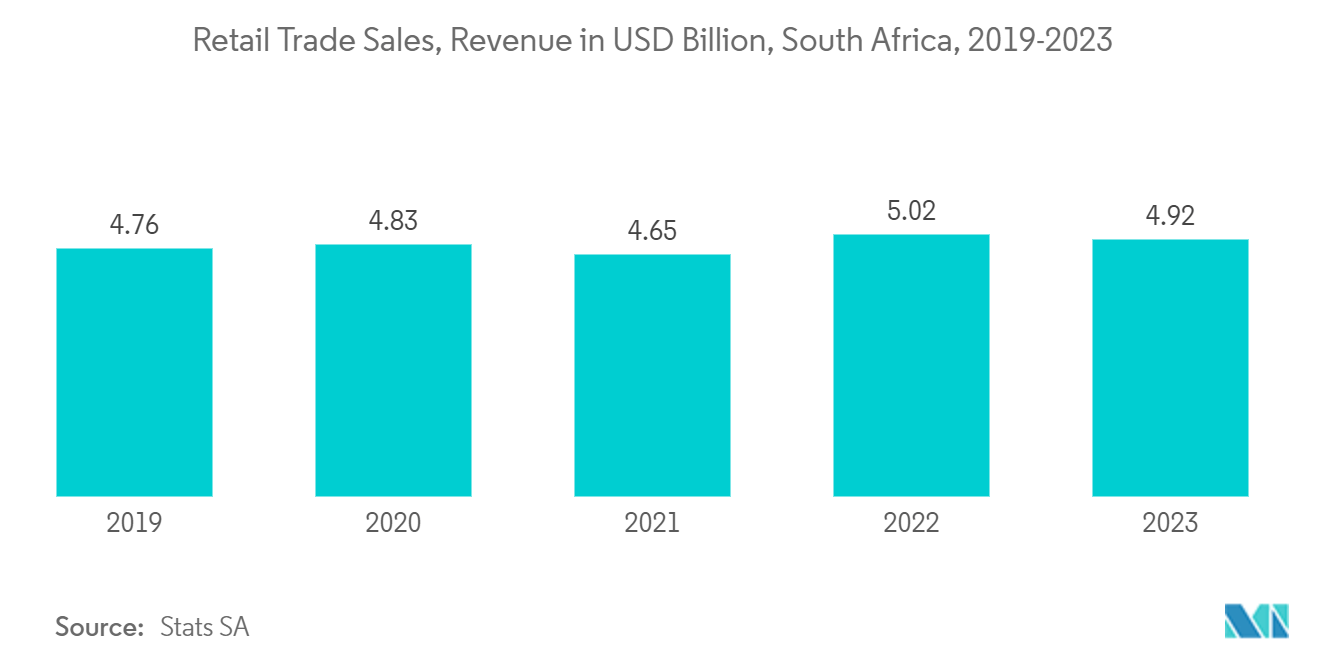
Saudi Arabia is Anticipated to Witness the Highest Growth
- The flexible packaging market in Saudi Arabia has been experiencing growth, driven by factors such as the increasing demand for convenience, changing consumer lifestyles, and a shift toward lightweight and sustainable packaging. The food industry remains a robust pillar of Saudi Arabia’s overall economy. The country boasts a thriving food manufacturing and processing sector, benefiting from population growth, rising incomes, government support, lifestyle shifts, and strong economic partnerships. Anticipated market expansion is driven by factors such as increasing urbanization, rapid growth in food delivery services, a rising number of young adults, and a growing working population.
- According to the Saudi Food Expo, Saudi Arabia and the United Arab Emirates jointly account for 90% of the food and beverage sector in the GCC region. Convenience features like resealability and portability have made pouch packaging popular for various products, including snacks, beverages, and processed foods. The Saudi government has seen interest in promoting economic diversification and sustainability. Policies and initiatives supporting these goals could impact the packaging industry, innovation, and environmentally friendly practices.
- Saudi Arabia is among the Middle Eastern region's significant markets for the packaging industry. The country has a broad consumer base and a wide range of industrial activities. As per the Saudi Arabian government, the country’s food industry is poised for a USD 20 billion boost by 2035, with a significant focus on enhancing the poultry, dairy, bakery, and sweets sectors. The infusion of new funds will also benefit the beverage and juice industries. This strategic investment aligns with the nation’s industrial strategy, aiming to bolster food security and implement economic diversification measures outlined in the Vision 2030 blueprint. Demand for packaged foods is growing, and more multinational companies are entering the market. Such investments are expected to boost the pouch packaging market in the country.
- Apart from the food and beverage industry, the pharmaceutical industry has also contributed significantly to the growth of flexible packaging. The increasing medical tourism and campaigns in countries are estimated to boost pharmaceutical sales and production. These factors are expected to positively affect the region’s healthcare industry, further boosting pharmaceutical production.
- FAS Riyadh reports that the traditional Saudi retail sector is lagging behind hypermarkets and supermarkets as demand for packaged food continues to increase. Major drivers of this shift include increasing disposable income, a growing population, and the creation and expansion of urban centers. Revenue in traditional retail channels has been declining due to the rapid expansion of hypermarkets and supermarkets. The retail sector is expected to continue to expand with the creation of more urban centers.
- As per USDA Foreign Agricultural Service, supermarkets in the United Arab Emirates generated revenue of USD 5,055 million in 2023. The rising sales of retail goods are creating opportunities for on-the-go packaging, driving innovations in the pouch packaging sector.
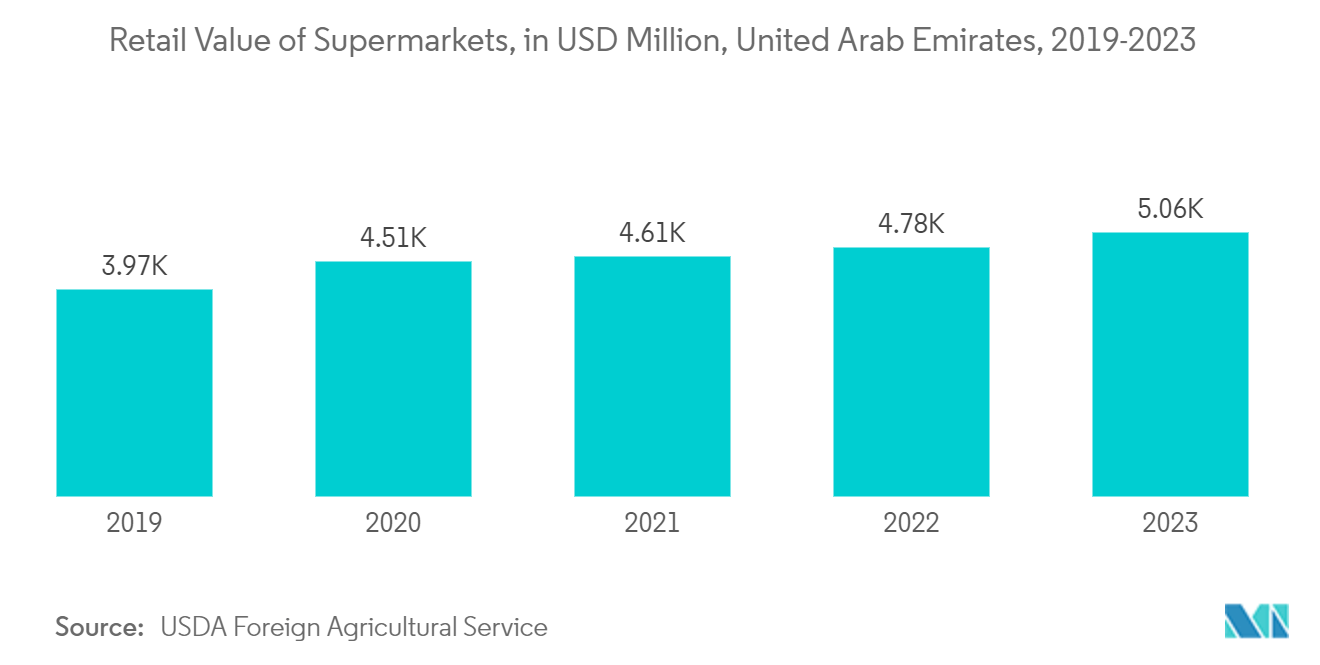
MEA Pouch Packaging Industry Overview
The Middle East and Africa pouch packaging market is fragmented due to the presence of several global players. Some major players are Amcor PLC, Coveris Management, Sealed Air Corporation, Mondi Group, and Constantia Flexibles Group GmbH. The players are expected to leverage the opportunity posed by the growth of several end-user verticals and are innovating to expand their market presence.
- April 2023: Hotpack Global, a UAE-based disposable packaging manufacturer and supplier, announced the development of a specialized food packaging project in Saudi Arabia. As part of the agreement, Hotpack Global will work with the Saudi Ministry of Industry to use certain agricultural waste as one of the basic components of raw materials for both future manufacturing and production input. The seven-year project costs SAR 1 billion (USD 266 million) and is claimed to be one of the largest specialized food packaging projects in Saudi Arabia.
- March 2023: Hexxa Flexible Packaging, a UAE-based provider of flexible packaging solutions, announced the purchase and installation of two new machines to address the growing regional demand for impactful flexible packaging. The company has purchased a high-speed slitting machine and an inspection rewind machine to foster Hexxa’s existing capabilities, which include two rotogravure printing presses, a narrow-web UV flexo press, lamination, slitting, pouching, and PVC-shrink sleeving machines. The new slitter is set to offer greater precision, consistency, and speed at 600 meters per minute, while the inspection rewind machine is equipped with a 100% defect detection system, enabling thorough examination of materials for printing defects and inconsistencies.
MEA Pouch Packaging Market Leaders
-
Amcor PLC
-
Sealed Air Corporation
-
Mondi Group
-
Constantia Flexibles Group GmbH
-
Coveris Management GmbH
*Disclaimer: Major Players sorted in no particular order
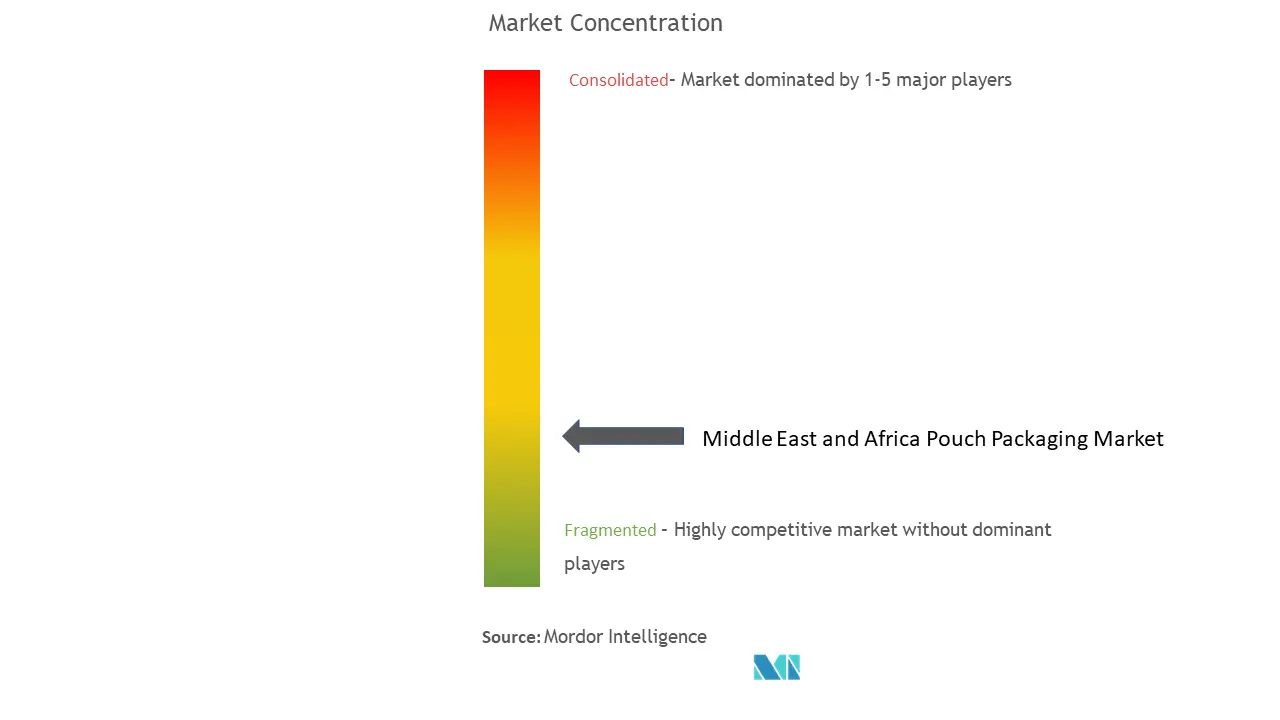
MEA Pouch Packaging Market News
- March 2024: Ishida Europe increased its footprint in Africa with the acquisition of South African packaging equipment manufacturer National Packaging Systems (NPS). NPS designs and manufactures vertical form, fill, and seal machines for sachets, stick packs, and pillow packs, as well as volumetric fillers, auger fillers, and feed systems. In addition to helping businesses increase levels of automation further, the new Ishida/NPS partnership should offer start-up operations the opportunity to take their first steps in automating their processes with the availability of high-quality and cost-effective entry-level weighing and packing systems.
- October 2023: ACMA and VOLPAK, part of the Coesia Group, specializing in the design and manufacturing of automatic packaging machines for consumer goods, announced its strategic expansion toward the Middle East and Africa market, backed by a technological offering in line with the needs of the industry and the region. The specific demands of this region have led VOLPAK to develop machines for the high-speed packaging of liquid and semi-liquid products such as juice and other sauces. Among the most popular solutions are the SP and SI series machines, which can form, fill, and seal pouches at medium and high speeds. The most popular formats are sachets (or flat pouches) and doypacks (stand-up pouches). Depending on how the product will be consumed, VOLPAK machinery also offers a wide range of pouch re-closing options, such as corner caps, top caps, or zippers.
MEA Pouch Packaging Market Report - Table of Contents
1. INTRODUCTION
- 1.1 Study Assumption and Market Definition
- 1.2 Scope of the Study
2. RESEARCH METHODOLOGY
3. EXECUTIVE SUMMARY
4. MARKET INSIGHTS
- 4.1 Market Overview
-
4.2 Industry Attractiveness - Porter's Five Forces Analysis
- 4.2.1 Bargaining Power of Suppliers
- 4.2.2 Bargaining Power of Buyers
- 4.2.3 Threat of New Entrants
- 4.2.4 Threat of Substitutes
- 4.2.5 Intensity of Competitive Rivalry
- 4.3 Industry Value Chain Analysis
5. MARKET DYNAMICS
-
5.1 Market Drivers
- 5.1.1 Increasing Demand for Convenient, Ready-to-Eat Food Products
- 5.1.2 Increasing Demand for Lightweight Packaging Solution
-
5.2 Market Challenges
- 5.2.1 Fluctuation in Raw Material Price
-
5.3 Trade Scenario
- 5.3.1 EXIM Data
- 5.3.2 Trade Analysis (Top 5 Import-Export Countries, Price Analysis, and Key Ports, Among Others)
- 5.4 Industry Regulations, Policies, and Standards
- 5.5 Technology Landscape
6. MARKET SEGMENTATION
-
6.1 By Material
- 6.1.1 Plastic
- 6.1.1.1 Polyethylene
- 6.1.1.2 Polypropylene
- 6.1.1.3 PET
- 6.1.1.4 PVC
- 6.1.1.5 EVOH
- 6.1.1.6 Other Resins
- 6.1.2 Paper
- 6.1.3 Aluminum
-
6.2 By Type
- 6.2.1 Standard
- 6.2.2 Aseptic
- 6.2.3 Retort
- 6.2.4 Hot Fill
-
6.3 By Product
- 6.3.1 Flat (Pillow & Side-Seal)
- 6.3.2 Stand-up
-
6.4 By End-User Industry
- 6.4.1 Food
- 6.4.1.1 Candy & Confectionery
- 6.4.1.2 Frozen Foods
- 6.4.1.3 Fresh Produce
- 6.4.1.4 Dairy Products
- 6.4.1.5 Dry Foods
- 6.4.1.6 Meat, Poultry, and Seafood
- 6.4.1.7 Pet Food
- 6.4.1.8 Other Food Products (Seasonings & Spices, Spreadables, Sauces, Condiments, etc.)
- 6.4.2 Medical and Pharmaceutical
- 6.4.3 Personal Care and Household Care
- 6.4.4 Other End user Industries (Automotive, Chemical, Agriculture)
-
6.5 By Country
- 6.5.1 United Arab Emirates
- 6.5.2 Saudi Arabia
- 6.5.3 Egypt
- 6.5.4 South Africa
- 6.5.5 Nigeria
- 6.5.6 Morroco
- 6.5.7 Rest of Middle East and Africa
7. COMPETITIVE LANDSCAPE
-
7.1 Company Profiles*
- 7.1.1 Amcor Group GmbH
- 7.1.2 Mondi Group
- 7.1.3 Constantia Flexibles Group GmbH
- 7.1.4 Coveris Management GmbH
- 7.1.5 Sealed Air Corporation (SEE)
- 7.1.6 Huhtamaki Oyj
- 7.1.7 Uflex Ltd
- 7.1.8 Napco National
- 7.1.9 Foster International Packaging
- 7.1.10 Emirates Printing Press (LLC)
8. INVESTMENT ANALYSIS
9. FUTURE OUTLOOK
** Subject To AvailablityMEA Pouch Packaging Industry Segmentation
Pouch packaging is a flexible product made from barrier films, paper, or foil, depending on the end-user’s requirement. The report analyzes the factors that impact geopolitical developments in the market studied based on the prevalent base scenarios, key themes, and end-user industries-related demand cycles. The analysis is based on the market insights captured through secondary research and the primaries. The market also covers the major factors impacting the growth of the pouch market in terms of drivers and restraints. The estimates exclude the weight and the cost of the content that is or is to be packed inside the pouch packaging solution. The scope of the study is limited to B2B demand.
The Middle East and Africa pouch packaging market is segmented by material type (paper, plastic, and aluminum), resin type - plastic (polyethylene, polypropylene, PET, PVC, EVOH, and other resins), product (flat [pillow and side seal] and stand up), type (standard, aseptic, retort, and hot fill), end-user industry (food [candy and snack food, processed food, fresh produce, dairy products, pet food, meat, poultry, seafood, and other food products], medical and pharmaceutical, personal care and household care, and other end-user industries), and country (United Arab Emirates, Saudi Arabia, Egypt, South Africa, Nigeria, Morocco, and Rest of Middle East and Africa). The market sizes and forecasts are provided in terms of value (USD) and volume (Units) for all the above segments.
| By Material | Plastic | Polyethylene |
| Polypropylene | ||
| PET | ||
| PVC | ||
| EVOH | ||
| Other Resins | ||
| By Material | Paper | |
| Aluminum | ||
| By Type | Standard | |
| Aseptic | ||
| Retort | ||
| Hot Fill | ||
| By Product | Flat (Pillow & Side-Seal) | |
| Stand-up | ||
| By End-User Industry | Food | Candy & Confectionery |
| Frozen Foods | ||
| Fresh Produce | ||
| Dairy Products | ||
| Dry Foods | ||
| Meat, Poultry, and Seafood | ||
| Pet Food | ||
| Other Food Products (Seasonings & Spices, Spreadables, Sauces, Condiments, etc.) | ||
| By End-User Industry | Medical and Pharmaceutical | |
| Personal Care and Household Care | ||
| Other End user Industries (Automotive, Chemical, Agriculture) | ||
| By Country | United Arab Emirates | |
| Saudi Arabia | ||
| Egypt | ||
| South Africa | ||
| Nigeria | ||
| Morroco | ||
| Rest of Middle East and Africa |
MEA Pouch Packaging Market Research FAQs
How big is the MEA Pouch Packaging Market?
The MEA Pouch Packaging Market size is expected to reach USD 2.03 billion in 2024 and grow at a CAGR of 5.59% to reach USD 2.67 billion by 2029.
What is the current MEA Pouch Packaging Market size?
In 2024, the MEA Pouch Packaging Market size is expected to reach USD 2.03 billion.
Who are the key players in MEA Pouch Packaging Market?
Amcor PLC, Sealed Air Corporation, Mondi Group, Constantia Flexibles Group GmbH and Coveris Management GmbH are the major companies operating in the MEA Pouch Packaging Market.
What years does this MEA Pouch Packaging Market cover, and what was the market size in 2023?
In 2023, the MEA Pouch Packaging Market size was estimated at USD 1.92 billion. The report covers the MEA Pouch Packaging Market historical market size for years: 2019, 2020, 2021, 2022 and 2023. The report also forecasts the MEA Pouch Packaging Market size for years: 2024, 2025, 2026, 2027, 2028 and 2029.
MEA Pouch Packaging Industry Report
Statistics for the 2024 MEA Pouch Packaging market share, size and revenue growth rate, created by Mordor Intelligence™ Industry Reports. MEA Pouch Packaging analysis includes a market forecast outlook for 2024 to (2024to2029 and historical overview. Get a sample of this industry analysis as a free report PDF download.



